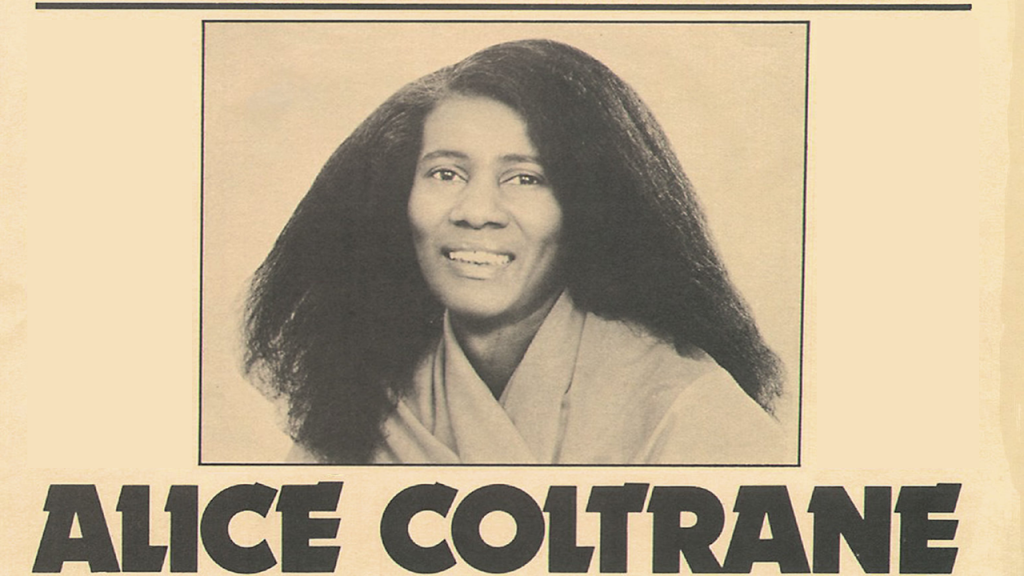Alice Coltrane Expands the Sonic Realm of Jazz
Misunderstood and dismissed by jazz gatekeepers for decades, Alice Coltrane’s compelling and mysterious style of jazz pushed the genre forward in previously unthinkable ways. Get to know her work with these five essential tracks.

Born in Detroit in 1937, the young Alice McLeod was a musical prodigy. She played organ at Mount Olive Baptist Church by age 9, discovered bebop in her teens and gigged with saxophonist Cannonball Adderley and Sonny Stitt before she was 20. She performed in various clubs around Detroit until moving to Paris in the late 1950s, where she studied classical music and jazz with noted musician Bud Powell and married to musician Kenny “Pancho” Hagood.
After her marriage to ended in divorce due to Hagood’s developing heroin addiction, she and her daughter moved back to Detroit, where she met John Coltrane in 1963.
From the start, Coltrane was her collaborator and her soulmate. Alice and John’s growing involvement in spirituality influenced John’s compositions and projects like “A Love Supreme.” At the time of its release, the album caused a bit of a stir in the jazz community, which reached an apex in 1966 when Alice replaced McCoy Tyner as primary pianist with John Coltrane’s group, drastically altering its sound. Critics felt that she was unduly influencing Coltrane’s sound and leading him away from “pure jazz.”
She and John continued playing and recording until his death in July 1967. When he died, Alice was devastated, but she continued to forge the musically spiritual and visionary path the two had earlier established, releasing records as a composer and bandleader.
Click on the player above to hear “5 on 5: Alice Coltrane” and explore the composer’s global-influence jazz below.
1. “Lovely Sky Boat”
Toward the end of his life, John Coltrane bought a harp, hoping that the instrument would help him rethink his approach to harmony and texture. Alice soon mastered the instrument, developing the dreamy rippling style that can be heard on ensemble recordings and on most of her future solo work.
Alice Coltrane’s first solo effort, 1968’s “A Monastic Trio,” debuts her harp playing as she conjures shimmering clouds of tone over exploratory bass lines. “Lovely Sky Boat” is one of the first to employ Coltrane’s harp and has had a longstanding influence on numerous groups, most notably Parliament Funkadelic.
The album would establish her compositional voice colored by blues, gospel and cosmic sounding tonalities.
2. “Blue Nile”
The next major developmental evolution in Coltrane’s sound came with the 1970 release, “Ptah, The El Daoud,” which expanded her musical sensibilities and also saw her add members to her band who would help her define her sound. She added saxophonist Pharoah Sanders and flautist Joe Henderson to an already potent mix that included Ron Carter on bass and Ben Riley on drums. The result was an album full of funky backbone, undulating soulful piano leads and blues-inflected gospel riffs.
3. “Stopover Bombay”
In the 1970s, Alice became a disciple of Swami Satchidananda, the guru who opened at the Woodstock Festival, and took on the name Turiyasangitananda. Coltrane met her guru in 1970, traveling to India with him, and that syncretic approach is reflected in the world music fusion of her 1971 album release “Journey In Satchidananda,” which began Coltrane’s voyage beyond jazz with its cosmic meanderings and deep atmospheric vibe. The album is as innovative as it is accessible with harp, soprano sax and tanpura wrapping around each other in a beautiful wall of sound.
4. “Sivaya”
After releasing signature follow-up albums such as “Universal Consciousness,” “World Galaxy” and “Lord of Lords,” Coltrane became more deeply involved with her spirituality and less involved with recording. The 1977 album “Transcendence” reflects this stage in her life as it explores Hindu-style songs, while maintaining a connection to jazz through complex harmonies and extended instrumental breaks. The album incorporates Indian and Nepalese traditions, gospel, spiritual jazz and New Age music.
5. “A Love Supreme”
From her 1972 release “World Galaxy,” Alice Coltrane reinterprets her husband’s iconic song “A Love Supreme,” offering her own mind-bending take on the iconic tune.
For many years, Alice Coltrane was misunderstood and dismissed by jazz purists and gatekeepers. Some considered her responsible for the break-up of her husband John Coltrane’s classic quintet. Others simply didn’t understand what her music was about, dismissing it as “hippy music.”
Since her passing in 2007, there has been a renewed appreciation for her music. Echoes of her influence can be hear in contemporary artists ranging from Bjork to Flying Lotus (her great-nephew) to Kamasi Washington.
While her late husband John Coltrane’s discography remains titanic in modern jazz, Alice’s albums are equally compelling and mysterious, moving away from jazz and into a unique sonic realm that draws on spiritual synth music, atonal modern orchestration and classical Indian instrumentation. The adventurous nature and spiritual import of her work continues to resonate through cosmic-style jazz, and experimental electronic music of all genres.
Related:
Jazz Trumpeter Tom Brown Makes His Own Lane
Iconic Producer and Rapper Q-Tip Blurs Genre Lines to Push Hip Hop Forward
The Progressive Underground’s Primer to Acid Jazz
Trusted, accurate, up-to-date
WDET is here to keep you informed on essential information, news and resources related to COVID-19.
This is a stressful, insecure time for many. So it’s more important than ever for you, our listeners and readers, who are able to donate to keep supporting WDET’s mission. Please make a gift today.
